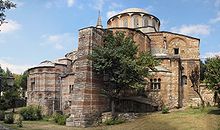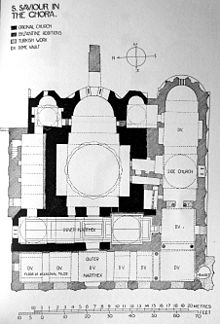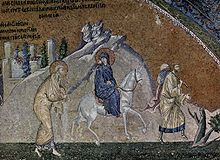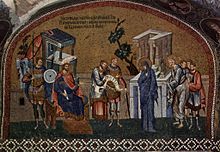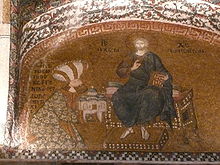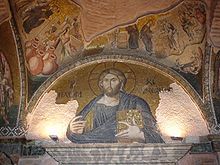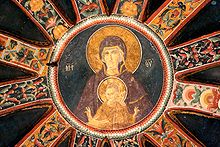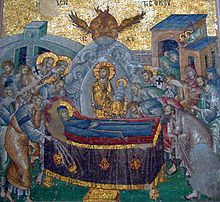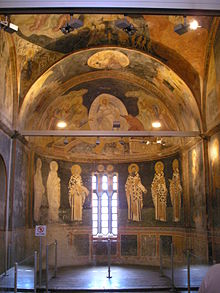- Chora Church
-
The Church of the Holy Saviour in Chora (Turkish Kariye Müzesi, Kariye Camii, or Kariye Kilisesi — the Chora Museum, Mosque or Church) is considered to be one of the most beautiful examples of a Byzantine church.[1] The church is situated in Istanbul, in the Edirnekapı neighborhood, which lies in the western part of the municipality (belediye) of Fatih. In the 16th century, the church was converted into a mosque by the Ottoman rulers, and it became a secularised museum in 1948. The interior of the building is covered with fine mosaics and frescoes.
Contents
History
The Chora Church was originally built outside the walls of Constantinople, to the south of the Golden Horn. Literally translated, the church's full name was the Church of the Holy Saviour in the Country: although "The Church of the Holy Redeemer in the Fields" would be a more natural rendering of the name in English. (Greek ἡ Ἐκκλησία του Ἅγιου Σωτῆρος ἐν τῃ Χώρᾳ, hē Ekklēsia tou Hagiou Sōtēros en tēi Chōrai).[2] The last part of that name, Chora, referring to its location originally outside of the walls, became the shortened name of the church. The original church on this site was built in the early 5th century, and stood outside of the 4th century walls of Constantine the Great. However, when Theodosius II built his formidable land walls in 413–414, the church became incorporated within the city's defences, but retained the name Chora. The name must have carried symbolic meaning, as the mosaics in the narthex describe Christ as the Land of the Living (ἡ Χώρα των ζώντων, hē Chōra tōn zōntōn) and Mary, the Mother of Jesus, as the Container of the Uncontainable (ἡ Χώρα του Ἀχώρητου, hē Chōra tou Achōrētou).
The majority of the fabric of the current building dates from 1077–1081, when Maria Dukaina, the mother-in-law of Alexius I Comnenus, rebuilt the Chora Church as an inscribed cross or quincunx: a popular architectural style of the time. Early in the 12th century, the church suffered a partial collapse, perhaps due to an earthquake. The church was rebuilt by Isaac Comnenus, Alexius's third son. However, it was only after the third phase of building, two centuries after, that the church as it stands today was completed. The powerful Byzantine statesman Theodore Metochites endowed the church with much of its fine mosaics and frescos. Theodore's impressive decoration of the interior was carried out between 1315 and 1321. The mosaic-work is the finest example of the Palaeologian Renaissance. The artists remain unknown. In 1328, Theodore was sent into exile by the usurper Andronicus III Palaeologus. However, he was allowed to return to the city two years later, and lived out the last two years of his life as a monk in his Chora Church.
During the last siege of Constantinople in 1453, the Icon of the Theotokos Hodegetria, considered the protector of the City, was brought to Chora in order to assist the defenders against the assault of the Ottomans.[3]
Around fifty years after the fall of the city to the Ottomans, Atık Ali Paşa, the Grand Vizier of Sultan Bayezid II, ordered the Chora Church to be converted into a mosque — Kariye Camii. Due to the prohibition against iconic images in Islam, the mosaics and frescoes were covered behind a layer of plaster. This and frequent earthquakes in the region have taken their toll on the artwork.
In 1948, Thomas Whittemore and Paul A. Underwood, from the Byzantine Institute of America and the Dumbarton Oaks Center for Byzantine Studies, sponsored a programme of restoration. From that time on, the building ceased to be a functioning mosque. In 1958, it was opened to the public as a museum — Kariye Müzesi.
Interior
The Chora Church is not as large as some of the other Byzantine churches of Istanbul (it covers 742.5 m²), but what it lacks in size, it makes up for in the beauty of its interior. The building divides into three main areas: the entrance hall or narthex, the main body of the church or naos, and the side chapel or parecclesion. The building has six domes: two in the esonarthex, one in the parecclesion and three in the naos.
Narthex
The main, west door of the Chora Church opens into the narthex. It divides north-south into the exonarthex and esonarthex.
Exonarthex
The exonarthex (or outer narthex) is the first part of the church that one enters. It is a transverse corridor, 4 m wide and 23 m long, which is partially open on its eastern length into the parallel esonarthex. The southern end of the exonarthex opens out through the esonarthex forming a western ante-chamber to the parecclesion. The mosaics that decorate the exonarthex include:
- Joseph's dream and journey to Bethlehem;
- Enrollment for taxation;
- Nativity, birth of Christ;
- Journey of the Magi;
- Inquiry of King Herod;
- Flight into Egypt;
- Two frescoes of the massacres ordered by King Herod;
- Mothers mourning for their children;
- Flight of Elizabeth, mother of John the Baptist;
- Joseph dreaming, return of the holy family from Egypt to Nazareth;
- Christ taken to Jerusalem for the Passover;
- John the Baptist bearing witness to Christ;
- Miracle;
- Three more Miracles.
- Jesus Christ;
- Virgin and Angels praying.
Esonarthex
The esonarthex (or inner narthex) is similar to the exonarthex, running parallel to it. Like the exonarthex, the esonarthex is 4 m wide, but it is slightly shorter, 18 m long. Its central, eastern door opens into the naos, whilst another door, at the southern end of the esonarthex opens into the rectangular ante-chamber of the parecclesion. At its northern end, a door from the esonarthex leads into a broad west-east corridor that runs along the northern side of the naos and into the prothesis. The esonarthex has two domes. The smaller is above the entrance to the northern corridor; the larger is midway between the entrances into the naos and the pareclession.
- Enthroned Christ with Theodore Metochites presenting a model of his church;
- Saint Peter;
- Saint Paul;
- Deesis, Christ and the Virgin Mary (without John the Baptist) with two donors below;
- Genealogy of Christ;
- Religious and noble ancestors of Christ.
The mosaics in the first three bays of the inner narthex give an account of the Life of the Virgin, and her parents. Some of them are as follows:
- Rejection of Joachim's offerings;
- Annunciation of Saint Anne, the angel of the Lord announcing to Anne that her prayer for a child has been heard;
- Meeting of Joachim and Anne;
- Birth of the Virgin Mary;
- First seven steps of the Virgin;
- The Virgin given affection by her parents;
- The Virgin blessed by the priests;
- Presentation of the Virgin in the Temple;
- The Virgin receiving bread from an Angel;
- The Virgin receiving the skein of purple wool, as the priests decided to have the attendant maidens weave a veil for the Temple;
- Zechariah praying, when it was the time to marry for the Virgin, High Priest Zechariah called all the widowers together and placed their rods on the altar, praying for a sign showing to whom she should be given;
- The Virgin entrusted to Joseph;
- Joseph taking the Virgin to his house;
- Annunciation to the Virgin at the well;
- Joseph leaving the Virgin, Joseph had to leave for six months on business and when he returned the Virgin was pregnant and he is suspicious of that.
Naos
The central doors of the esonarthex lead into the main body of the church, the naos. The largest dome in the church (7.7 m diameter) is above the centre of the naos. Two smaller domes flank the modest apse: the northern dome is over the prothesis, which is linked by short passage to the bema; the southern dome is over the diaconicon, which is reached via the parecclesion.
- Koimesis, the Dormition of the Virgin. Before ascending to Heaven, her last sleep. Jesus is holding an infant, symbol of Mary's soul;
- Jesus Christ;
- Theodokos, the Virgin Mary with child.
Parecclesion
To the right of the esonarthex, doors open into the side chapel, or parecclesion. The parecclesion was used as a mortuary chapel for family burials and memorials. The second largest dome (4.5 m diameter) in the church graces the centre of the roof of the parecclesion. A small passageway links the parecclesion directly into the naos, and off this passage can be found a small oratory and a storeroom. The parecclesion is covered in frescoes:
- Anastasis, the Resurrection. Christ, who had just broken down the gates of hell, is standing in the middle and pulling Adam and Eve out of their tombs. Behind Adam stand John the Baptist, David, and Solomon. Others are righteous kings;
- Second coming of Christ, the last judgment. Jesus is enthroned and on both sides the Virgin Mary and John the Baptist (this trio is also called the Deesis);
- Virgin and Child;
- Heavenly Court of Angels;
- Two panels of Moses.
Notes
See also
- Icon of the Hodegetria
- Monastery of the Panaghia Hodegetria
- Church of the Virgin Pammakaristos
References
- Van Millingen, Alexander (1912). Byzantine Churches of Constantinople. London: MacMillan & Co.
- Ousterhout, Robert (2002). The Art of the Kariye Camii. London-Istanbul: Scala. ISBN 975-6899-76-x.
Literature
- Chora: The Kariye Museum. Net Turistik Yayinlar (1987). ISBN 978-9754790450
- Feridun Dirimtekin. The historical monument of Kariye. Türkiye Turing ve Otomobil Kurumu (1966). ASIN B0007JHABQ
- Semavi Eyice. Kariye Mosque Church of Chora Monastery. Net Turistik Yayinlar A.S. (1997). ISBN 978-9754794441
- Çelik Gülersoy. Kariye (Chora). ASIN B000RMMHZ2
- Jonathan Harris, Constantinople: Capital of Byzantium. Hambledon/Continuum (2007). ISBN 978 1847251794
- Krannert Art Museum. Restoring Byzantium: The Kariye Camii in Istanbul and the Byzantine Institute Restoration. Miriam & IRA D. Wallach Art Gallery (2004). ISBN 1884919154
- Robert Ousterhout (Editor), Leslie Brubaker (Editor). The Sacred Image East and West. University of Illinois Press (1994). ISBN 978-0252020964
- Robert G. Ousterhout. The Architecture of the Kariye Camii in Istanbul. Dumbarton Oaks Research Library and Collection. (1988). ISBN 978-0884021650
- Saint Saviour in Chora. A Turizim Yayinlari Ltd. (1988). ASIN B000FK8854
- Cevdet Turkay. Kariye Mosque. (1964). ASIN B000IUWV2C
- Paul A. Underwood. The Kariye Djami in 3 Volumes. Bollingen (1966). ASIN B000WMDL7U
- Paul A. Underwood. Third Preliminary Report on the Restoration of the Frescoes in the Kariye Camii at Istanbul. Harvard University Press (1958). ASIN B000IBCESM
- Edda Renker Weissenbacher. Kariye: The Chora Church, Step by Step. ASIN B000RBATF8
External links
 Media related to Chora Church at Wikimedia Commons
Media related to Chora Church at Wikimedia Commons- Columbia University | Restoring Byzantium | The Kariye Camii in Istanbul and the Byzantine Institute Restoration
- Byzantium 1200 | Chora Monastery
- Interior and exterior pictures in http://rubens.anu.edu.au
- Photos with explanations
- visit info Kariye (Chora) Museum, Istanbul, Turkey Travel Planner by Tom Brosnahan.
- BYZANTINE MOSAICS OF CHORA MONASTERY
- Chora Museum Website
Coordinates: 41°01′52″N 28°56′21″E / 41.03111°N 28.93917°E
Topics on the Byzantine Empire History Roman Empire → Dominate → Early Byzantine period (Constantinian dynasty → Valentinian dynasty → Theodosian dynasty → Leonid dynasty → Justinian dynasty → Heraclian dynasty) → Middle Byzantine period (Isaurian dynasty → Amorian dynasty → Macedonian dynasty → Doukid dynasty → Komnenian dynasty → Angelid dynasty) → Late Byzantine period (Fourth Crusade → Latin Empire, Empire of Nicaea, Epirus, Trebizond, and other successor states) → Palaiologan dynasty → Fall to the Ottoman Empire)Government and
AdministrationCentral government: Emperors (Basileus) · Senate · Imperial Bureaucracy · Eparch · Early period (Praetorian prefects · Magister officiorum · Comes sacrarum largitionum · Quaestor sacri palatii) · Middle period (Logothetes · Sakellarios) · Late Byzantine period (Megas logothetes · Mesazon)
Provincial administration: Early period (Praetorian prefectures · Dioceses · Provinces · Exarchate of Ravenna · Exarchate of Africa) · Middle period (Themes · Kleisourai · Catepanates) · Late period (Kephale · Despotates)
Diplomacy: Treaties · DiplomatsLaw Military Byzantine army (Late Roman army → East Roman army → Middle Byzantine army → Komnenian army → Palaiologan army): Battle tactics · Military manuals · Wars and Battles · Revolts · Siege warfare · Generals · Foederati · Bucellarii · Tagmata · Domestic of the Schools · Mercenaries · Varangian Guard · Akritai · Pronoia
Byzantine navy: Karabisianoi · Maritime themes (Cibyrrhaeots · Aegean Sea · Samos) · Dromon · Greek fire · Megas doux · Admirals · Naval battlesReligion and Church Eastern Orthodox Church · Ecumenical councils · Patriarchate of Constantinople · Arianism · Monophysitism · Paulicianism · Iconoclasm · Great Schism · Bogomilism · Hesychasm · Mount Athos · Jews · MuslimsSociety and Culture Architecture: Secular · Sacred (Cross-in-square) · Constantinople (Great Palace of Constantinople · Blachernae Palace · Hagia Sophia · Hagia Irene · Chora Church · Pammakaristos Church · City Walls) · Thessalonica (Arch of Galerius and Rotunda · Hagios Demetrios · Hagia Sophia · Panagia Chalkeon) · Ravenna (San Vitale · Sant'Apollinare in Classe · Sant'Apollinare Nuovo) · Daphni Monastery · Hosios Loukas · Nea Moni of Chios · Saint Catherine's Monastery, Mount Sinai · Mystras · Revival
Art: Icons · Mosaics · Painters · Macedonian period art · Komnenian renaissance
Economy: Agriculture · Coinage and Mints · Trade (Silk · Silk Road · Trade with the Varangians)
Literature: Novel · Acritic songs (Digenes Akritas) · Alexander romance · Historians
People and everyday life: People · Byzantine Greeks · Heraldry · Hippodrome · Calendar · Cuisine · Dance · Dress · Music
Science and learning: Inventions · Medicine · Neoplatonism · Philosophy · Encyclopaedism · Scholars in the Renaissance · Scholars · UniversityLegacy/Other topics Categories:- Mosques converted from churches in Istanbul
- 1080s architecture
- Churches in Istanbul
- Museums in Istanbul
- Byzantine sacred architecture
- Byzantine art
- Constantinople
- Church buildings established in the 5th century
- Fatih, Istanbul
Wikimedia Foundation. 2010.


